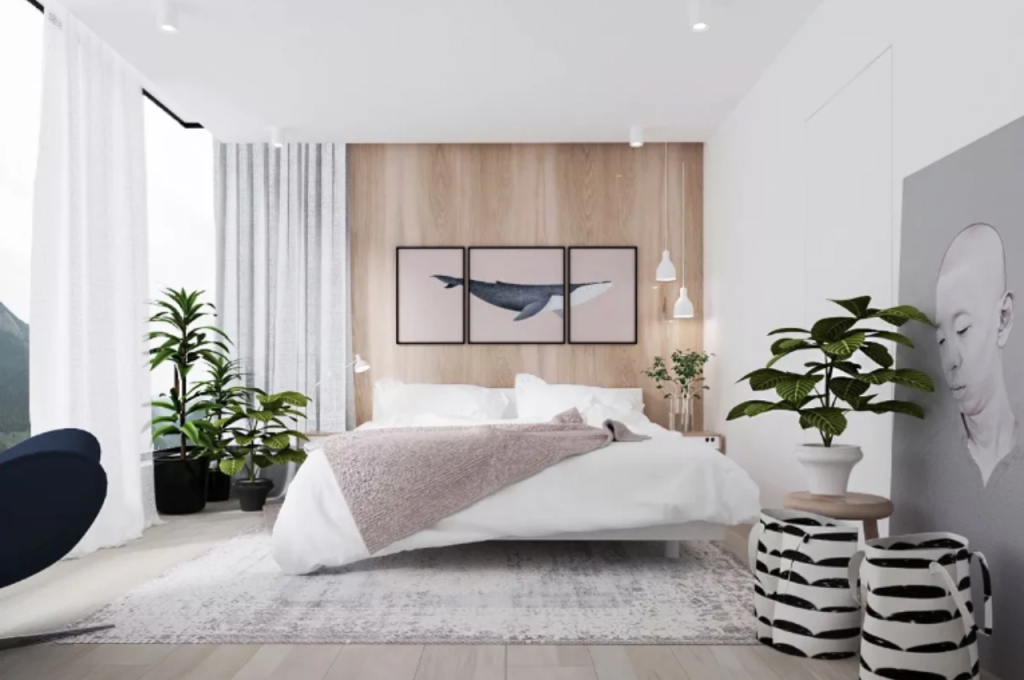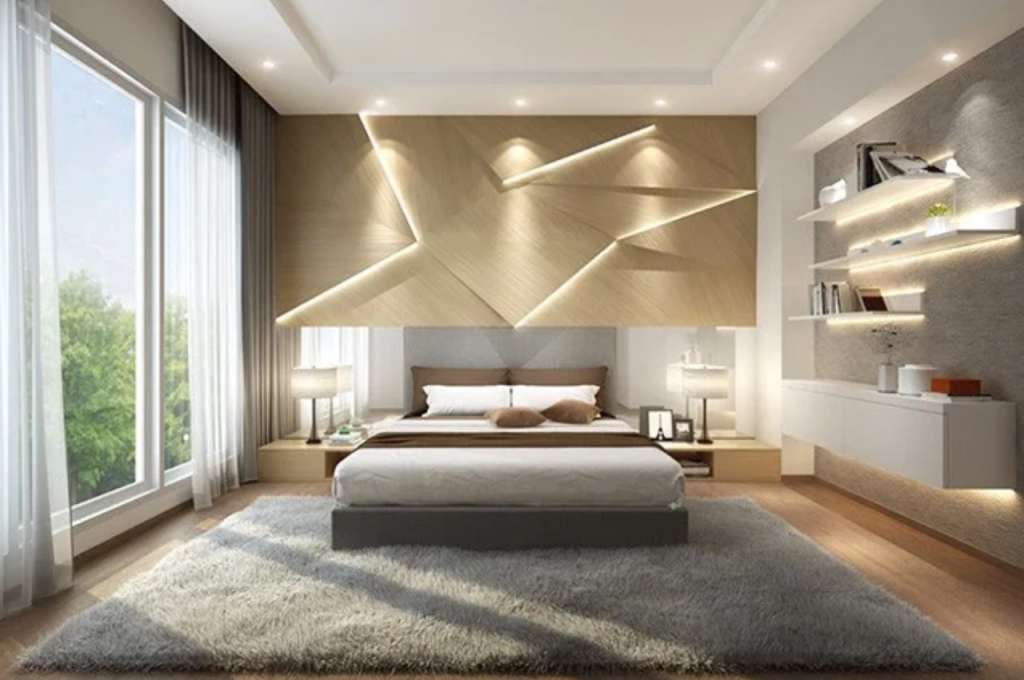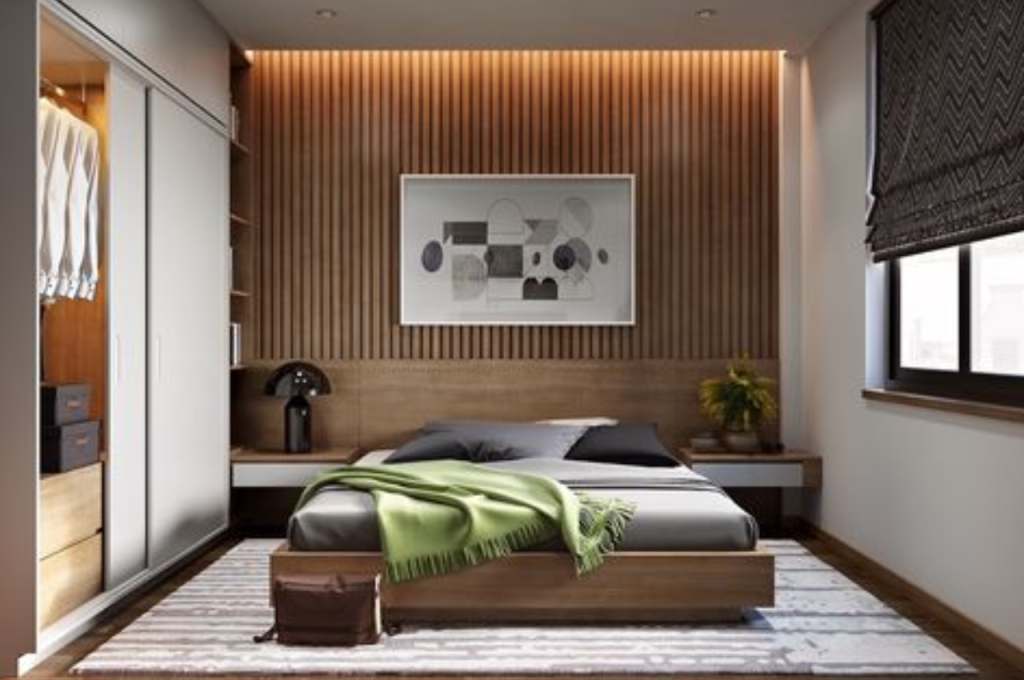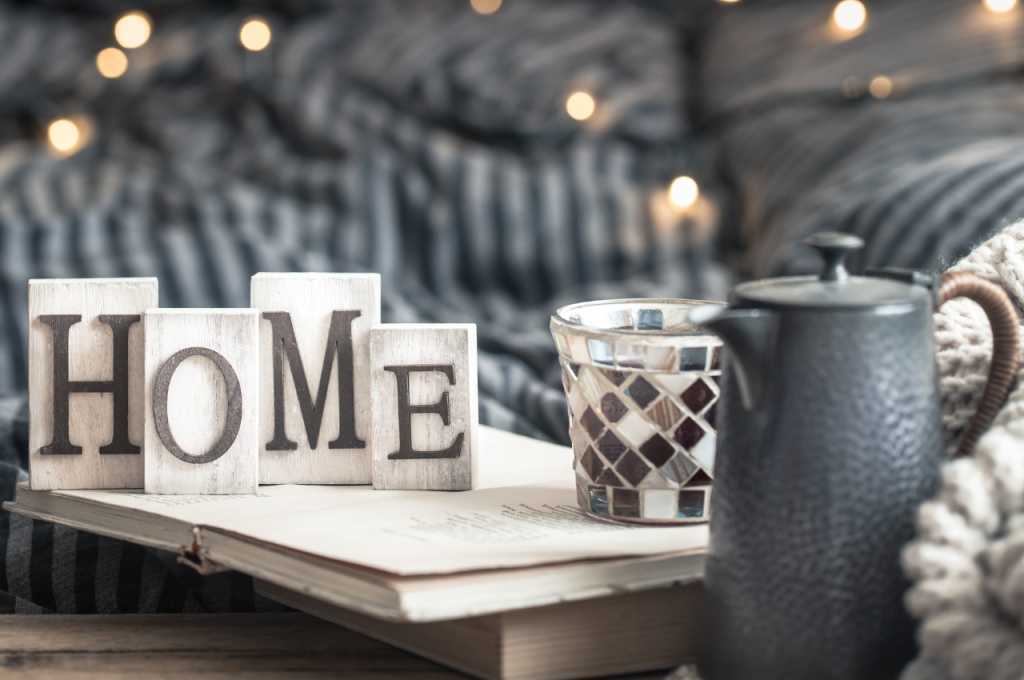A bedroom without furniture can create a spacious and minimalist aesthetic, promoting a sense of tranquility and relaxation. The absence of furniture allows for more open space and provides a sleek and modern atmosphere.
However, it is essential to add key elements like a bed, nightstands, and a dresser to make the room functional and comfortable. By choosing furniture pieces that complement the room’s style and color palette, you can create a cohesive and inviting space.
Consider incorporating soft textiles and accessories to add warmth and personality to the room while maintaining its clean and uncluttered look. Remember, balance is key in designing a bedroom without furniture to ensure both visual appeal and functionality.
Benefits of A Furniture-free Bedroom
A furniture-free bedroom can offer a range of advantages that promote a healthier and more restful environment. By embracing minimalism in the sleeping space, individuals can experience improvements in various aspects of their well-being.

Improved Sleep Quality
- A furniture-free bedroom promotes better rest by reducing clutter and distractions.
- The minimalist setting can enhance relaxation and lead to deeper sleep cycles.
- With fewer items in the room, the mind can unwind more effectively, aiding in falling and staying asleep.
Enhanced Air Quality
- A furniture-free bedroom minimizes dust accumulation, improving overall air quality.
- Less furniture means less surface area for dust to settle and fewer hidden allergens.
- Improved air circulation can contribute to a fresher and healthier environment for quality sleep.
Designing A Furniture-free Bedroom
Designing a furniture-free bedroom can be a unique and creative way to embrace minimalism, create an open and spacious feel, and promote relaxation. By incorporating minimalist decor, a functional layout, and integrating natural elements, you can transform your bedroom into a serene and inviting space without traditional furniture.
Minimalist Decor
Achieving a furniture-free bedroom starts with adopting a minimalist decor approach. Embrace clean lines, neutral color palettes, and clutter-free surfaces. Consider opting for floor cushions, hanging wall art, and simple textiles to add warmth and visual interest to the space without the need for conventional furniture.
Functional Layout
When designing a furniture-free bedroom, prioritize a functional layout that maximizes the available space. Arrange the room to optimize movement and flow, with designated areas for sleeping, relaxation, and storage. Utilize multi-purpose storage solutions such as built-in shelves or under-bed storage to maintain organization and minimize clutter.
Natural Elements Integration
Integrating natural elements into a furniture-free bedroom can create a calming and harmonious ambiance. Incorporate indoor plants, natural sunlight, and organic textures to connect with the outdoors and promote a sense of tranquility. Consider utilizing sustainable materials for any furnishings or accents to further enhance the eco-friendly and serene atmosphere.
Organizing Essentials for A Furniture-free Bedroom
A bedroom without furniture may sound like an unconventional idea, but it’s a concept that is gaining popularity among minimalists, budget-conscious individuals, and those seeking a more open and spacious feel to their sleeping quarters. However, just because you don’t have traditional furniture in your bedroom doesn’t mean you have to sacrifice organization. With a few simple organizing essentials, you can create a clutter-free and functional space that will leave you wondering why you ever needed furniture to begin with.
Clothing Storage Solutions
When it comes to organizing your clothing in a furniture-free bedroom, innovative storage solutions are key. By maximizing the use of your walls, you can create a visually pleasing and highly functional system to keep your clothes tidy and easily accessible.
- Wall-mounted clothing rack: Install a sturdy wall-mounted clothing rack to hang your most frequently worn items. This not only keeps them wrinkle-free but also adds a stylish element to your bedroom.
- Under-bed storage boxes: Utilize the space beneath your bed by investing in low-profile storage boxes. These can be used to store seasonal clothing, spare bedding, or even shoes, helping to keep your bedroom clutter-free.
- Door-mounted hooks: Install hooks on the back of your bedroom door to hang scarves, belts, and other accessories. This simple addition maximizes vertical space and ensures easy access to your smaller clothing items.
- Decorative baskets: Utilize decorative baskets to store folded clothes, such as t-shirts or pants. Not only do they keep your clothing neatly organized, but they also add a touch of texture and style to your bedroom decor.
Multi-functional Furniture Alternatives
While you’ve chosen a furniture-free bedroom, there may still be some pieces that serve multiple purposes and provide storage solutions without taking up valuable floor space. Look for multi-functional alternatives that blend seamlessly into your minimalist bedroom aesthetic.
- Floor-to-ceiling storage units: Invest in floor-to-ceiling shelving units that can store books, decorative items, and other personal belongings. These units not only provide ample storage space but also act as a statement piece in your bedroom.
- Modular storage cubes: Opt for modular storage cubes that can be stacked and rearranged to fit your specific needs. These versatile cubes can be used as bedside tables, shoe racks, or even seating when topped with a cushion.
- Hanging fabric pockets: Hang fabric pockets on your wall or the back of your bedroom door to store smaller items such as jewelry, cosmetics, or even socks. These pockets are easily accessible and keep your belongings visible and organized.
Creative Shelving Ideas
When it comes to creating additional storage in a furniture-free bedroom, shelving plays a crucial role. With a bit of creativity, you can incorporate unique shelving ideas that not only provide storage but also enhance the aesthetics of your bedroom.
- Floating shelves: Install floating shelves at varying heights to showcase decorative items and books. These shelves create a visually interesting display while making use of vertical wall space.
- Pegboard wall: Transform one wall into a pegboard storage system. By attaching hooks and shelves to the pegboard, you can easily organize and display your belongings while adding an industrial touch to your bedroom.
- Rope shelves: Use thick ropes to create suspended shelves. These unique shelves not only add a playful touch to your bedroom but also provide storage space for smaller items like plants or ornaments.
- Corner shelves: Utilize the corners of your bedroom by installing triangular or hexagonal shelves. These space-saving shelves are perfect for displaying books, small plants, or personal mementos.
Maximizing Space in A Furniture-free Bedroom
A furniture-free bedroom presents the opportunity to think creatively about space utilization. Without traditional furniture pieces, it becomes essential to explore alternative methods to maximize the available space effectively.
Utilizing Vertical Space
In a furniture-free bedroom, utilizing vertical space is crucial for creating functional storage. Installing wall-mounted shelves not only maximizes floor space but also provides a convenient way to organize and display items. Additionally, using hanging organizers and hooks on the walls can help keep belongings tidy and accessible.
Incorporating Hidden Storage
Incorporating hidden storage within the bedroom design is an effective way to maintain a clutter-free environment. Consider incorporating under-bed storage containers or utilizing bed frames with built-in drawers. Concealed storage solutions such as ottomans with hidden compartments can also serve as seating options while providing additional space for stowing items out of sight.
Furniture-free Seating Options
When opting for a furniture-free bedroom, consider alternative seating options such as floor cushions, poufs, or bean bags. These flexible seating choices not only contribute to a cozy atmosphere but also can be easily moved or stacked to accommodate various activities within the space.
Creating A Relaxing Ambiance in A Furniture-free Bedroom
A furniture-free bedroom can be a refreshing and innovative way to transform your personal space. By eliminating bulky furniture pieces, you open up the room and create a spacious, calming environment. But how do you create a relaxing ambiance without the traditional elements found in typical bedrooms? In this blog post, we will explore effective strategies to enhance your furniture-free bedroom and cultivate a serene atmosphere that promotes relaxation and a sense of tranquility.

Proper Lighting Strategies
When it comes to a furniture-free bedroom, lighting plays a crucial role in setting the mood and enhancing the overall ambiance. Opt for soft and warm lighting options that help create a cozy and intimate atmosphere. Consider incorporating these lighting strategies:
- Install dimmer switches to adjust the intensity of the lights according to your needs.
- Utilize table lamps or wall sconces for localized, softer lighting.
- Hang fairy lights or string lights to add a touch of whimsy and a subtle glow.
By using these lighting strategies, you can transform your furniture-free bedroom into a cozy retreat where you can unwind and relax.
Soothing Color Schemes
The colors in your bedroom play a significant role in influencing your mood. When it comes to a furniture-free bedroom, opt for soothing color schemes that create a tranquil atmosphere. Consider these calming colors:
- Soft shades of blue, such as sky blue or light seafoam, promote a sense of calm and tranquility.
- Neutral tones like beige, ivory, or pale gray create a serene and cozy ambiance.
- Earthy colors such as sage green or warm taupe evoke a natural and soothing vibe.
By choosing these soothing color schemes for your furniture-free bedroom, you can create a serene and peaceful environment conducive to relaxation and rejuvenation.
Aromatherapy and Greenery
Enhance the ambiance of your furniture-free bedroom by incorporating aromatherapy and greenery. These elements can uplift your mood and create a calming atmosphere:
| Aromatherapy | Greenery |
| Use essential oils like lavender or chamomile in a diffuser or as a linen spray to create a relaxing scent throughout the room.Choose scented candles with calming fragrances such as vanilla, sandalwood, or jasmine. | Place small potted plants, such as aloe vera or peace lilies, near the window to bring a touch of nature into your bedroom.Hang eucalyptus branches in the shower area for their soothing aroma and aesthetic appeal. |
By incorporating aromatherapy and greenery into your furniture-free bedroom, you can create a tranquil and relaxing space that promotes a sense of well-being and rejuvenation.
Enhancing Functionality in A Furniture-free Bedroom
Creating a bedroom without traditional furniture can open up a world of possibilities when it comes to enhancing functionality and maximizing space utilization. Without bulky beds, dressers, and nightstands, you can design a bedroom that is not only visually appealing but also versatile in its layout and purpose. In this article, we will explore three key ways to enhance functionality in a furniture-free bedroom: flexible room layouts, multipurpose furniture alternatives, and technology integration.
Flexible Room Layouts
One of the main advantages of a furniture-free bedroom is the freedom to experiment with flexible room layouts. Without being limited by the fixed positions of beds and dressers, you can easily rearrange your room to suit different activities or accommodate new additions. Whether you prefer an open, spacious feel or need additional floor space for a yoga session, a furniture-free bedroom allows you to adapt the room layout with ease.
Here are some ideas for creating a flexible room layout:
- Use area rugs or floor cushions to define different zones within the room, such as a sleeping area, a reading nook, or a meditation corner.
- Install floating shelves on the walls to provide storage and display space for personal belongings without cluttering the floor.
- Hang curtains or room dividers to create a visual separation between different areas while maintaining an open-concept design.
Multipurpose Furniture Alternatives
While a furniture-free bedroom may not have traditional pieces like beds and dressers, there are plenty of alternative options available that combine functionality and style. These multipurpose furniture alternatives can serve multiple functions, saving both space and money. Here are a few examples:
| Image | Description |
| A bed desk that can be transformed into a comfortable sleeping surface at night and a functional workspace during the day. | |
| A storage ottoman that not only provides a place to sit but also offers concealed storage space to keep your belongings organized. | |
| Retractable furniture, such as folding tables or wall-mounted desks, that can be easily tucked away when not in use, freeing up valuable floor area. |
Technology Integration
A furniture-free bedroom presents an excellent opportunity to incorporate technology seamlessly into your living space. By strategically integrating technology, you can enhance the functionality and comfort of your bedroom. Here are a few ways to do it:
- Install smart lighting systems that allow you to control the brightness and color of the lights using your smartphone or voice commands.
- Invest in a smart thermostat that automatically adjusts the temperature based on your preferences, ensuring a comfortable sleep environment.
- Mount a wall-mounted TV or projector screen that can be conveniently hidden when not in use to maintain a minimalist aesthetic.
Embracing a furniture-free bedroom allows for endless possibilities for enhancing functionality. By creating flexible room layouts, exploring multipurpose furniture alternatives, and integrating technology, you can transform your bedroom into a versatile and efficient space tailored to your unique needs and preferences.
Maintaining A Furniture-free Bedroom
Having a furniture-free bedroom can be a refreshing and liberating experience. Not only does it create a sense of spaciousness, but it also promotes simplicity and minimalism. With proper maintenance, your furniture-free bedroom can stay clutter-free and pristine. In this article, we will provide you with practical tips on regular decluttering practices, cleaning tips for simplicity, and upcycling and repurposing ideas.
Regular Decluttering Practices
Regular decluttering is essential to keep your furniture-free bedroom organized and serene. Follow these simple practices to keep your space clutter-free:
- Set aside a dedicated time each week to declutter. This can be as little as 10 minutes a day or a longer session once a week.
- Start by sorting through your belongings and prioritizing what you truly need in your bedroom.
- Create designated areas for different items, such as a basket for dirty laundry or a drawer for books and magazines.
- Regularly assess your belongings and question whether they still serve a purpose or bring you joy. If not, consider donating or selling them.
- Optimize storage spaces by using baskets, organizers, and hooks. This will help keep items off the floor and maintain a tidy look.
Cleaning Tips for Simplicity
Cleaning a furniture-free bedroom is relatively straightforward. Follow these simplicity-focused cleaning tips:
- Sweep or vacuum the floor regularly to remove dust and debris. Choose environmentally friendly cleaning products to minimize clutter and uphold a natural atmosphere.
- Wipe surfaces, including shelves, windowsills, and walls, with a damp cloth to eliminate any dust particles.
- Keep bedding simple and easy to maintain by using washable bedding materials and avoiding excessive decorative pillows or throws.
- Wash curtains or blinds regularly to prevent dust buildup.
- Take advantage of the open space to promote airflow and ensure proper ventilation.
Upcycling and Repurposing
Instead of disposing of unwanted items, consider upcycling and repurposing them to bring a creative touch to your furniture-free bedroom:
| Upcycling Ideas | Repurposing Ideas |
| Turn old crates into bedside tables. | Transform an old ladder into a bookshelf. |
| Repaint and repurpose mason jars as candle holders or makeup brush organizers. | Convert an old trunk into a storage chest or seating area. |
| Transform an old window frame into a decorative wall mirror. | Use an unused frame as an earring or accessory holder. |
By upcycling and repurposing items, you not only give them a new lease on life but also reduce waste and add a unique charm to your furniture-free bedroom.
Personalizing A Furniture-free Bedroom
In a furniture-free bedroom, personalization is key to creating a cozy and inviting space that reflects your unique style and personality. By focusing on thoughtful decor, textiles, and personal touches, you can transform a minimalist bedroom into a tranquil sanctuary. Let’s explore the essential elements of personalizing a furniture-free bedroom.
Artwork and Decor Selection
Artwork and decor play a crucial role in personalizing a furniture-free bedroom. Select artwork that resonates with your taste, whether it’s bold, minimalist, or eclectic. Consider incorporating a mix of wall art, framed photographs, and decorative objects to add visual interest to the space.
Textiles and Cushions
Textiles and cushions are essential for adding warmth and comfort to a furniture-free bedroom. Choose soft textiles such as cozy throw blankets, plush area rugs, and accent pillows to create a layered and inviting atmosphere. Opt for textures and patterns that complement your design aesthetic and contribute to the overall coziness of the room.
Adding Personal Touches
Infuse your personality into the bedroom by incorporating personal touches that reflect your interests and experiences. This could include displaying meaningful mementos, arranging a collection of your favorite books, or showcasing sentimental items that hold special significance to you. By curating a space that authentically represents who you are, you can create a truly personalized furniture-free bedroom.

Conclusion
Creating a bedroom without furniture offers endless possibilities for personalization and creativity. By utilizing space efficiently and incorporating multifunctional items, one can achieve a minimalist, spacious feel. The key lies in smart organization and clever design choices.
Embracing simplicity and mindfulness will result in a serene and inviting sleep space.

